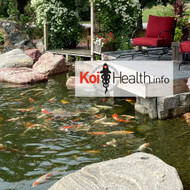Understanding Koi Parasites
Posted by Ellen Kloubec on 19th Oct 2022
As koi hobbyists we’re all searching for the newest, latest and greatest, thing to make, and keep our pets healthy. So, we go out and buy the newest, latest and greatest, product and install it in our pond system. Then, we’d like to forget about koi health, koi parasites treatments or water quality until a crisis develops. Are you the kind of individual who thinks if your pond water looks fine then everything must be fine? If it ain’t broke, don’t fix it. Why treat the pond if my koi don’t have a problem? Do any of these this sound familiar?
Well, koi parasites happen. It’s a fact of koi keeping. They exist in virtually any body of water that contains fish. Eventually parasites will find your koi, because your koi is a perfect host. So, it’s up to you to prevent parasites from invading your fish’s happy home. Your fish are depending on you to keep their environment as clean and parasite free as possible.
One philosophy on koi health and parasites is Preventive Maintenance. I developed this philosophy during my formidable school years. To this day I can still recall my Shop & Auto Mechanic teacher’s motto, "Preventative maintenance, preventive maintenance, and preventive maintenance!" As a student I heard these words every single day during his class and I believe it speaks true with our koi. We must prevent parasites on a regular basis. Don’t wait until your favorite fish is flashing and rubbing on the edge of the pond, has blood-stained spots or is piping for air at the pond surface. Prevent parasites, prevent parasites, and prevent parasites!
As a dog or cat owner we regularly worm our family pet against internal and external parasites. The pet requires vaccinations on a fixed schedule. Don’t you regularly change the oil in your car as maintenance, too? So, as a fish owner, why should our fish-husbandry be any different?
Obvious signs of a parasite infestation:
- fish rubbing on the pond bottom or edges
- hanging under waterfalls
- lack of feeding
- lying on the pond bottom
- sores, lesions or ulcers
- loss of weight
- flashing
- isolation
Even healthy fish can host parasites. In fact, your koi pond and its inhabitants may be harboring or cycling parasites at this very minute. Healthy fish can and do live with a small number of parasites for years. However, if your fish become stressed or sick the parasites will gain an edge and flourish. That can lead to serious complications, up to and including the death of your pet. When koi are weak from stress parasites are encouraged to multiply.
A microscope is necessary for koi parasite identification. Most koi parasites are microscopic, with the exception of adult Anchor Worms and Fish Lice. These are visible to the unaided eye but are quite small and easily overlooked. You may become suspicious of their presence long before seeing an adult parasite. A proper koi parasite diagnosis should be made prior to any koi parasites treatment being applied.
If you have ever seen a fish parasite under the microscope they’re quite fascinating. Weird little organisms, some are kind of cute. Have you ever seen a fish louse with a 10x power lens? They have funny little faces… but big and cruel intentions. It’s scary how much damage can be caused by something we can’t see with our own eyes. Keeping a journal of fish activity, water quality parameters and any pond treatments performed will be a great resource when the time for action arrives.
When we treat our ponds, the koi parasites treatment usually kill most of the adult parasites and parasite larvae. But, ever so often a few parasites will remain in an untouched cache of water or some may have burrowed under your koi’s slime coat. They are as happy as a ‘bug-in-a-rug’ when you treat your pond. They are safe and sound under that slime coat. And soon, they’re going to make babies! Lots of new tiny little fish damaging parasites. Just because you killed the parasites today doesn’t mean your koi won’t become subjected to a new batch of parasites tomorrow! Pond owners should treat for parasites on a regular basis. The parasitic cycle must be broken. Adults need to be eliminated, young parasites in the larval stage be killed and any still in the form of eggs removed as well. Parasites don't take a break; some are prevalent in warm water, while others make an appearance when the water temperature is low. Koi can contract both internal and external parasites. Usually skin lesions will develop where parasites have attached. To make matters worse, secondary infections are common following parasite infestations.
Your fish are dependent on you for parasite prevention. Remember that all parasites have a common goal; feed and breed.
For expert advice on Koi Health visit our very own website www.koihealth.info


